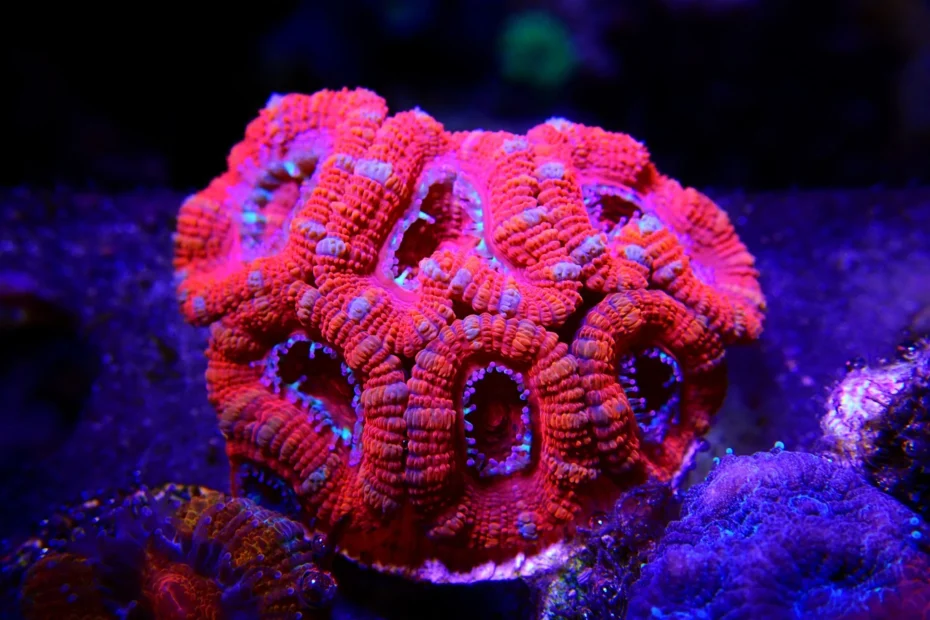Acanthastrea Coral (Acan Coral, Micromussa Lordhowensis)
Quick Guide:
• Common Name: Acan Coral, Acan Lord, Micromussa
• Scientific Name: Acanthastrea spp. (Micromussa lordhowensis)
• Class: Anthozoa
• Origin: Indo-Pacific, Australia, Fiji, Indonesia
• Category: LPS (Large Polyp Stony Coral)
• Care Level: Beginner to Intermediate
• Temperament: Semi-aggressive (short sweeper tentacles)
• Lighting: Low to Medium (PAR 50-150)
• Flow: Low to Moderate (gentle, indirect flow)
• Placement: Bottom to Middle (best on rockwork or sandbed)
• Growth Rate: Moderate
Overview:
Acanthastrea corals, commonly referred to as Acan corals, are among the most colorful and sought-after LPS corals in the reef-keeping hobby. Known for their vibrant hues of red, orange, green, blue, and purple, these corals add incredible contrast to reef tanks. Due to taxonomic reclassification, most Acanthastrea species have been reclassified as Micromussa lordhowensis, though they are still widely known as “Acans” in the hobby.
Tank Requirements & Water Parameters:
Acan corals thrive in stable water conditions:
• Temperature: 76-80°F (24-27°C)
• pH: 8.1-8.4
• Salinity: 1.024-1.026 SG
• Alkalinity: 8-10 dKH
• Calcium: 400-450 ppm
• Magnesium: 1300-1400 ppm
• Nitrate: 5-15 ppm (prefers moderate nutrients)
• Phosphate: 0.03-0.1 ppm
Unlike some corals that require ultra-low nutrients, Acan corals prefer a slightly nutrient-rich environment, making them great for mixed reefs where moderate feeding occurs.
Lighting Needs:
Acan corals do well under low to moderate lighting (50-150 PAR). They are naturally found in shaded or deeper reef areas, so they do not require intense light. Excessive lighting can lead to color loss or tissue retraction.
Flow Requirements:
Moderate but indirect flow is best. Too much flow can cause polyps to retract, while too little may allow detritus to accumulate. An alternating, gentle flow pattern works well.
Feeding & Nutrition:
While Acans contain symbiotic zooxanthellae for photosynthesis, they greatly benefit from direct feeding. Their fleshy polyps extend at night, making nighttime the best time to target feed. Offer:
• Meaty foods (Mysis shrimp, brine shrimp, krill, chopped seafood)
• Powdered coral foods (Reef Roids, Coral Frenzy, Benepets)
• Amino acid supplements (helps with growth and coloration)
Feeding 2-3 times per week can significantly boost growth and polyp extension.
Placement & Aggression:
• Best placed in the bottom to middle section of the tank, avoiding direct strong lighting.
• Semi-aggressive, though not as aggressive as some LPS corals like Torch or Hammer corals. It has short sweeper tentacles, so ensure a few inches of space from neighbors.
Growth & Propagation:
Acan corals grow moderately fast under good conditions. They form colonies of fleshy polyps that expand over time, encrusting onto surrounding rockwork.
• Fragging is simple: Use a bone cutter or bandsaw to cut between polyps. Allow fragged pieces to heal in lower flow before reintroducing them into the main tank.
Popular Color Morphs & Variations:
Acan corals come in an incredible range of colors and patterns, with some of the most popular including:
• Rainbow Acan – Multicolored with vibrant reds, greens, oranges, and blues
• Ultra Red Acan – Deep, bright red with contrasting centers
• Toxic Green Acan – Bright green polyps with darker rims
• Jawbreaker Acan – A mix of deep purples, oranges, and greens
• Blue Ice Acan – Rare blue and teal hues
Challenges & Common Issues:
• Bleaching or color loss – Usually caused by excessive lighting; move to a shaded area if colors start fading.
• Receding tissue – Can be due to aggression from nearby corals or lack of feeding.
• Algae growth on tissue – Avoid placing Acans in high-nutrient areas without proper flow, as algae can grow on retracted polyps.
